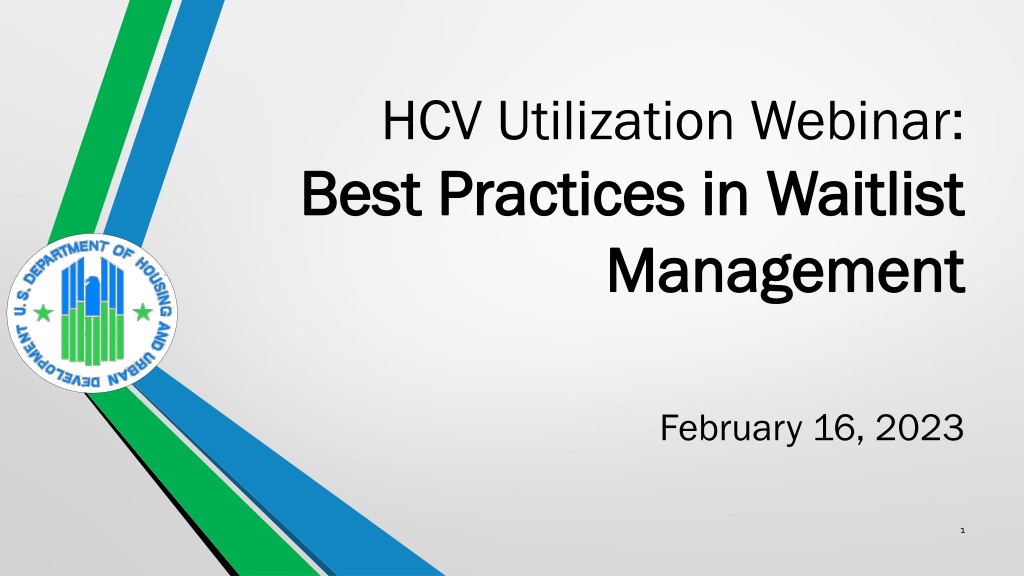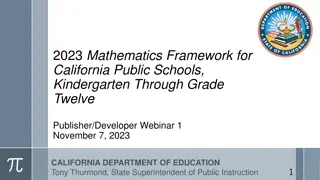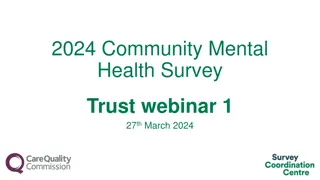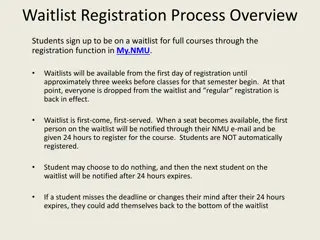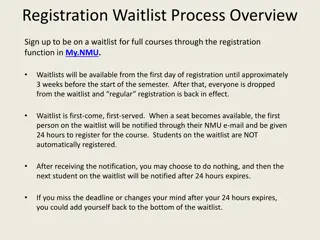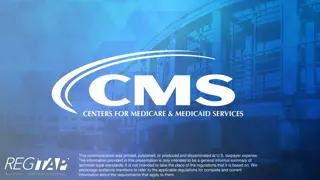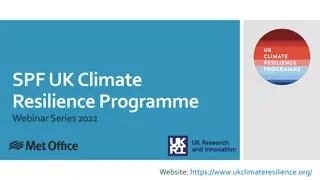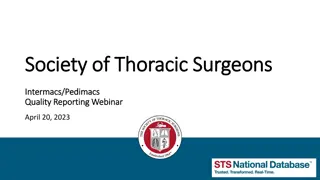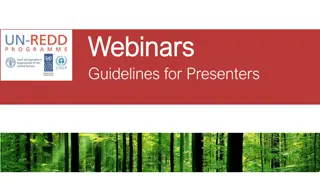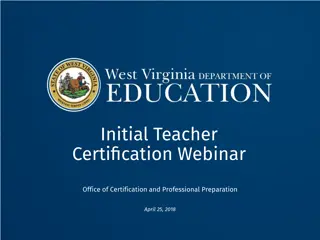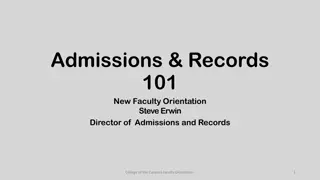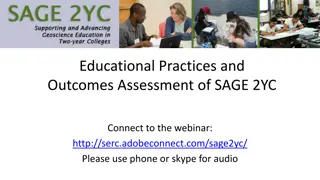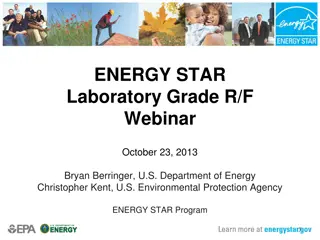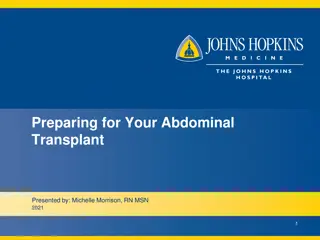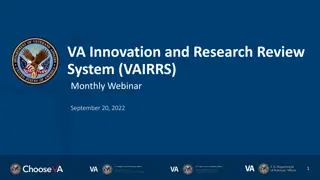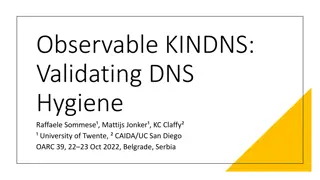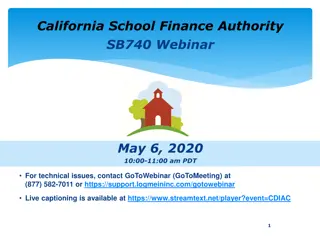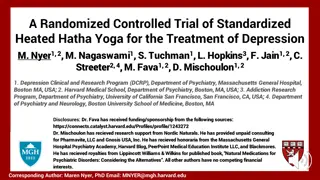Best Practices in Waitlist Management Webinar
This webinar focuses on best practices in waitlist management for the HCV program. It covers topics such as program updates, waitlist rules, regulations, and best practices from various housing authorities. The content discusses the purpose of the waiting list, opening the waiting list, conducting outreach, and more. Stay updated on the latest information for effective waitlist management.
Download Presentation

Please find below an Image/Link to download the presentation.
The content on the website is provided AS IS for your information and personal use only. It may not be sold, licensed, or shared on other websites without obtaining consent from the author. Download presentation by click this link. If you encounter any issues during the download, it is possible that the publisher has removed the file from their server.
E N D
Presentation Transcript
HCV Utilization Webinar: Best Practices in Waitlist Best Practices in Waitlist Management Management February 16, 2023 1
Welcome! Today's webinar is being recorded. The recording and PowerPoint will be posted to the "Webinars and Trainings section of www.hud.gov/hcv in about a week. We are always interested in your feedback. Please enter any suggestions you have for how we can make these webinars or the program resources more useful to you in the chat. Stay connected by visiting www.hud.gov/hcv and subscribing to the HCV Connect Newsletter. 2
Agenda 1. Program Updates Patrick Hatch 2. Wait List Rules and Regs Emily Warren, MOD 3. Wait List Best Practices (PHAs) Western Piedmont Council of Governments (Hickory, NC) Elizabeth Moncrief, Housing Program Manager Stephanie Hanvey, Director Housing Authority of New Orleans (HANO) Nyssa LeBeau, Director 3
Program Updates 2023 Funding Update Inflation Proration/Offset Two-Year Tool Waiver Reminder (PIH 2022-30) 120% PS Waiver Immediate Implementation 4
Purpose of the Waiting List Establishes the order in which the PHA issues vouchers to qualified applicants All HCV admissions must be waiting list admissions unless they meet criteria as a special admission (24 CFR 982.202(a)) The PHA must maintain one waiting list for all tenant- based assistance, including special purpose vouchers* (24 CFR 982.204(f)) 6
Opening the Waiting List PHAs can choose to keep their waiting list open indefinitely or open waiting list for brief periods only Any public notice announcing an opening should be simple, direct, and clear To reach a diverse applicant pool, PHAs should think creatively in its outreach efforts 7
Conducting Outreach Outreach strategies may vary based on whether the waiting list opening is targeting a specific group Before a specific group is targeted, the preference must be included in the PHA s admin plan (24 CFR 982.207(a)) In cases where the PHA has been awarded an SPV award to serve a certain category of families, the PHA does not have to establish a preference for that category 8
Updating the Waiting List Determining the time to update the waiting list could be based on such factors as: Length of waiting time or length of waiting list Number of families contacted to reach an eligible applicant PHAs must state policy for removing applicant names from the waiting list in their admin plan (24 CFR 982.204(c)(1)) HUD encourages PHAs to contact an unresponsive applicant by all available means before removing them from the waiting list 9
Updating the Waiting List HUD does not define specific process for updating the waiting list To avoid barriers for persons experiencing homelessness, PHAs are encouraged to collect multiple contact information to reach applicants PHAs must reinstate an applicant if the family s failure to respond was due to a family member s disability or status as a victim of domestic violence, dating violence, sexual assault, or stalking ((24 CFR 982.204(c)(2)); Final Rule: Violence Against Women Reauthorization Act of 2013: Implementation in HUD Housing Programs ) 10
Maintaining the Waiting List PHAs must collect the following information from applicants (24 CFR 982.204): Name Family unit size Date/time of application Qualifications for any local preference Race/ethnicity of the head of household 11
Maintaining the Waiting List Additionally, PHAs should collect the following to report in its Annual Plan (24 CFR 903.7): Elderly families and families that include individual(s) with disabilities Families who require mobility or hearing/vision accessible units, or other accessibility features Families with incomes below 30% of Area Median Income (AMI) 12
Maintaining the Waiting List PHAs may choose to merge its HCV waiting list with lists for another federal or local housing assistance program (24 CFR 982.205(a)(1)) When admitting an applicant family, admission for each federal program is subject to the federal regulations for that program (24 CFR 982.205(a)(1)) 13
Closing the Waiting List PHAs are encouraged to close the waiting list when they do not have sufficient available units to assist all applicants within a reasonable period of time A PHA may choose to partially close its waiting list and continue to accept applications from families qualifying for a specific local preference A PHA cannot accept applications for a closed waiting list solely for those qualifying for a residency preference 14
Closing the Waiting List Before closing the waiting list, the PHA should consider whether its waiting list includes a sufficient number of extremely low-income families to satisfy the 75% income targeting requirement Any opening and closing of the waiting list must comply with civil rights and fair housing requirements 15
Accepting Applications PHAs have the discretion to decide on the method of accepting and processing applications, but they typically consider the following factors: Number of families expected to apply Leasing rate and current/future availability of vouchers Size of HCV program Current size of waiting list Staff capacity and other administrative constraints Applicable court orders, voluntary compliance agreements and other mandatory directives Barriers faced by potential applicants related to application submission methods 16
Accepting Applications HUD encourages PHAs to use multiple methods of application submission to comply with affirmative marketing and fair housing obligations, including: Online applications On-site paper applications Applications by mail, email, and fax Applications by telephone (must be accessible for individuals who are deaf and with Limited English Proficiency) 17
Processing Applications HUD does not mandate the format or content of an HCV application or submission method except for: The application must be provided in accessible formats for persons with disabilities (24 CFR 8.6; 28 CFR 35.161) The application must be translated into other languages in accordance with the four factors described in HUD s LEP Guidance ( Final Guidance to Federal Financial Assistance Recipients Regarding Title VI Prohibition Against National Origin Discrimination Affecting Limited English Proficient Persons ) 18
Processing Applications PHAs may choose to have applicants complete a pre- application form that collects only the information required to place the family on the waiting list A pre-application may be appropriate when there will be a wait for assistance PHAs with no waiting list or a very short waiting list may choose to use only a full application form 19
Full Application Form Information on any convictions that would make the applicant ineligible and any relevant mitigating circumstances Information on sex offender registration requirements for any household member Information on any other screening required by PHA policy Demographic information for tracking purposes (race/ethnicity, household size, housing status) A certification that the information provided is accurate and complete Information to compute income and determine allowances/adjusted income Family composition and unit size requirements Information to determine qualification for preferences Name and address of current and previous landlord Information on previous evictions from federally assisted housing for drug-related activity and relevant circumstances 20
Preferences PHAs may establish preferences for admittance to their HCV program. The preferences must be: Described in the admin plan (24 CFR 982.207(a)(1)) Consistent with the PHA s Annual Plan (24 CFR 982.207(b)(1)(iii)) Based on local housing needs and priorities (24 CFR 982.207(a)(2)) 21
Preferences Preferences are only used to establish order on the waiting list PHAs may not deny an eligible applicant based on failure to qualify for a preference PHAs cannot adopt a preference for higher-income families (24 CFR 982.207(d)) PHAs may limit the number of applicants that qualify for any preference (24 CFR 982.207(a)(3)) PHAs may select among applicants with the same preference status using date/time of submission, lottery, or other random selection method (24 CFR 982.207(c)) 22
Types of Preferences Residency preference Working family preference Homeless preference Preference for categories of single persons over other single persons (24 CFR 982.207(b)) 23
Verification of Preferences While PHAs are not required to verify preference eligibility at pre-application, PHAs are encouraged to include a self- certification clause If the PHA determines the family does not qualify for a claimed preference, the family may be returned to the waiting list in the position they originally would have held without preference consideration Preferences should be easy for applicants to understand and easily verified 24
Applying Preferences PHAs must address how each local preference is applied in its admin plan Several methods can be used, including: Lumping Aggregating Ranking 25
Selection from the Waiting List Applicants must be selected using one of the following methods after all applicable preferences are applied (24 CFR 982.207(c)): Date/time stamp of application Lottery or other randomized method Regardless of the selection method, the PHA must leave a clear audit trail that can be used to verify that each applicant was selected in accordance with the method and preferences outlined in the PHA s admin plan (24 CFR 982.207(e)) 26
Western Piedmont Council of Governments Hickory, NC Stephanie Hanvey, RHA Director 828.485.4224 stephanie.hanvey@wpcog.org
Waiting List Management How often to open? Our goal is to offer assistance to all of our applicants in one year Keeps information current and applicants motivated to keep in contact and respond Stay open for 2-3 weeks with a goal of about 2,500 applicants If we offer about 150 - 175 applicants each month, we will typically be able to reopen by the one year goal Why close at all? We tried that and the same people kept reapplying without an urgency to lease Closing allows us to be able to serve all applicants on the list, including those without preference points
Waiting list and Leasing We study our housing stats 50% - If we offer 150 applicants assistance, we may receive 50% applications returned. 20 - 30% - Of the 75 vouchers offered, about 30% or less, will lease about 23 10% - We lose about 10-15 vouchers per month through attrition Over the course of 2022, we were able to maintain and even increase our utilization rate to over 98% despite market conditions. We can now slow down. Other ways to help applicants Online pre-applications and online way to update contact information Increase time to turn in documents/verifications Communicate a myriad of ways including Zoom and in-person voucher briefings
Nyssa LeBeau, Director Nyssa LeBeau, Director Housing Choice Voucher Program Housing Choice Voucher Program (504) 670 (504) 670- -3344 3344 nlebeau@hano.org nlebeau@hano.org
History of HANOs HCVP Waiting Lists History of HANO s HCVP Waiting Lists 2009 HCVP Waiting List Over 28,000 applicant families Took 10 years to consider all applicants 2016 HCVP Waiting List Over 24,000 applicant families Took 3 years to even start working the list Roughly 7 years to consider all applicants 2022 HCVP Waiting List Roughly 10,500 applicants Started working the list within two months Hoping to consider all applicants within 2-3 years First round of eligibility interviews had a 64% response rate
Techniques to Reduce Wait Time and Techniques to Reduce Wait Time and Increase Utilization Increase Utilization Waiting List Purge of 2016 Waiting List Started in 2019 and completed in 2021 Altered policy to provide 30-day response period Response rate of 27% Of the purge respondents, 64% responded to outreach for eligibility screening Closely Monitoring the Two-Year Tool Never stop working the list or issuing vouchers to applicant families Regular evaluation of success rates and procedures for extending search time Ensuring that families that take longer than 150 days to search are accounted for in success rate tracking Adding local limited preferences for homeless families utilizing Notice PIH 2013-15 Partnering with homeless service provider or consortiums for direct referrals
Reminders We urge PHAs to take advantage of the recent program updates to support leasing: New 2023 FMRs Payment Standard Waivers (PIH Notice 2022-30) Administrative Fee Flexibility (PIH Notice 2022-29) Now is not the time to press pause on HCV leasing. Please continue to use the Two-Year-Tool to make HCV program decisions. Need help? Contact your local Public Housing Field Office and/or visit www.hud.gov/hcv. 33
